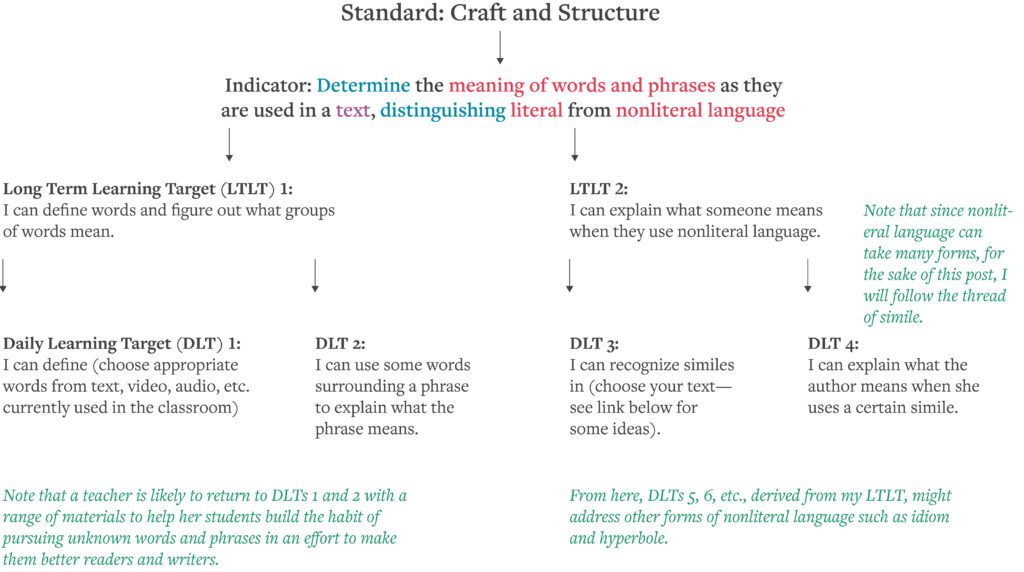Editor’s note: Our “Unpacking” Series provides a deeper look into the ideas of Clarity, one of JumpRope’s Core Values.
Know where to go; know how to get there. This is very good advice for any journey, including the metaphorical journey of teaching and learning. I am increasingly aware, though, that knowing these things in the abstract is very different from embedding them into our day-to-day practice. If the standards we work with are (one of the) destinations, the path toward them must include understanding what they mean in terms of instruction and assessment. In Figuring Out Learning Expectations I offered some options for how to examine and digest standards, to imbue them with meaning so we can make reasonable instructional choices. The discussion in that post is work that exists at the curriculum planning level. The work of knowing where to go and how to get there at the classroom level will be my focus here and in a few subsequent posts.
There is more than one way to break down standards and there is more than one terminus for a deconstructed standard.
Once we figure out the learning expectations at the curricular level, we need to break them down so they become actionable in our 45-, 70-, 90-minute class periods. There is more than one way to break down standards and there is more than one terminus for a deconstructed standard. The critical thing to keep in mind in going through this process is it should enable teachers to say to students, “this is what you will learn” and “this is what you will be assessed on.” Even a quick look at CSSS, NGSS, or ACTFL, to name a few sets of standards, allows us to see that they give us the finish line, not the checkpoints, that help our students and us see progress toward that finish line. Breaking them down or unpacking them gives us actionable learning and assessment targets. For current and prospective JumpRope users, the broken down or “unpacked” standards can become the standards bank. Here is the unpacking process I use in working with in-service and pre-service teachers. At JumpRope, we think this process also points to possible steps to take in creating an understandable and actionable standards bank.
1. Figure out your starting place for unpacking. I begin at the indicator level. Take a look at this doc to see sample standards and indicators from CCSS, NGSS, and ACTFL.
2. Color-code at the indicator level. Here’s an example from CCSS, Reading Standards for Literature 6-12, Key Ideas and Details:
KEY
Red = “the what” Blue = type of thinking Green = context
Determine a theme or central idea of a text and analyze its development over the course of the text, including its relationship to the characters, setting, and plot; provide an objective summary of the text.
For extended guidance on color-coding as a facet of unpacking, take a look at Unpacking Standards, Part 1.
3. Use the color code to help you break down the indicator into Long Term Learning Targets (LTLTs).
4. I almost always start with looking at the verbs (type of thinking in blue) in the indicator to figure out what my LTLTs might be and how many of them I think I might create. In looking at the verbs, I try to figure out what they mean, what it would look like in action, how a student would show that thinking skill. I rely on thinking taxonomies to help me with this step. Here are a few I like: Bloom, Webb, and Marzano.
5. Then, I figure out if that thinking skill needs to be applied to more than one “what” (content in red).
6. And finally, I look to see if the indicator names a specific context I need to use or if I can choose my context.

After I have color-coded the indicator, I break it down into manageable instructional and assessment targets. This process is distinct from that which I discuss in Figuring Out Learning Expectations in that the goal here is to determine the instructional target(s); the target(s) to guide our daily planning and to share with students to guide their learning. In the graphic below I use a third grade CCSS in literacy as an example of how I move from standard to indicator to long term learning target (LTLT) to daily learning target (DLT). The indicator is the only portion of the learning goal that came from a source other than me.

Reference: Teaching Similes and Metaphors
With this system, I would summatively assess at the LTLT level. I would collect summative assessment data for my grade book or, in the case of JumpRope, my standards bank, at this level. It’s certainly possible in some cases to summatively assess at the indicator level, but we will save that discussion for another time. I would collect formative assessment data at the LTLT level, and informally check for understanding throughout and after instruction at the DLT level.
As I go through the above process, I keep a few important rules of thumb in mind. First, as Robert Marzano reminds us, there is such a thing as aiming for too many instructional and assessment benchmarks in a course or classroom. He names 25 as the upper number of benchmarks for a single content area across an academic year. At JumpRope, we’ve learned across our many years of helping districts, schools, and teachers develop grade books, that attempting to assess too many standards is untenable for teachers and ineffective for students. If we buy into the idea that naming our learning and assessment targets is helpful for our students and us, it’s not a tough leap to also buy into the idea that naming too many things to teach and assess won’t be good for any of us.
Let us know if you’d like to learn more about using some of our ideas for creating a standards bank. We want you to be as effective as you can be with your students so they can succeed in their learning and assessment tasks.

